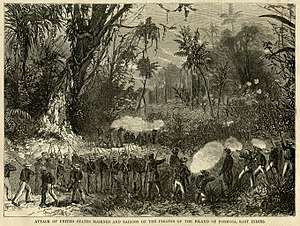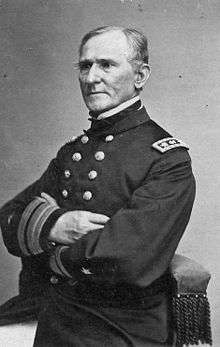Formosa Expedition
The Formosa Expedition,[1] or the Taiwan Expedition of 1867 was a punitive expedition launched by the United States against Formosa. The expedition was undertaken in retaliation for the Rover incident, in which the Rover, an American bark, had been wrecked and its crew massacred by aboriginal Paiwan warriors in March 1867. A United States Navy and Marine company landed in southern Formosa and attempted to advance into the native village. The natives deployed a significant amount of guerrilla warfare, which they ambushed, skirmished, disengaged and retreated repeatedly. Eventually, the Marines ceased their pursuit when their commander was killed and retreated back to their ship due to fatigue and heat exhaustion, with the Formosans dispersing and retreating back into the jungle. The action is regarded as an American failure.[2]
| Formosa Expedition | |||||||
|---|---|---|---|---|---|---|---|
 Attack of United States Marines and Sailors on the pirates of the island of Formosa, East Indies, Harper's Weekly | |||||||
| |||||||
| Belligerents | |||||||
| Paiwan |
| ||||||
| Commanders and leaders | |||||||
| Tok-a-Tok |
| ||||||
| Strength | |||||||
| 22 |
181 2 sloops-of-war | ||||||
| Casualties and losses | |||||||
| None | 1 killed | ||||||
Background

On 12 March 1867, the United States merchantman Rover was sailing off Oluanpi, Formosa when she wrecked on an uncharted reef and began drifting out to sea. Her crew of over two dozen safely made it ashore but were attacked and killed by the Paiwanans. The Royal Navy ship HMS Cormorant reached the "Koalut country" on March 26,[3] discovered the fate of the Rover and informed the American East India Station. Squadron commander Rear Admiral Henry H. Bell ordered Commander John C. Febiger in the newly commissioned gunboat USS Ashuelot to proceed from Fuzhou to the island for an investigation of the incident.
Upon arrival Qing authorities assured Commander Febiger that the attack was carried out by warriors of a village that did not practice respect of the nation's laws. With this information, Ashuelot returned and notified Rear Admiral Bell. The American consul to Xiamen, C. W. Le Gendre, had spent the month of April trying to establish communication with the tribes but the Koaluts remained hostile.[4]
At this point, diplomatic pressure proved a failure. After a delay of three months and "a good deal of red tapeism in Washington", a punitive expedition was decided on.[4] Bell, with the screw sloop-of-war Wyoming and his flagship Hartford left Shanghai in June for southern Formosa.
Expedition
The passing from Shanghai to Formosa was uneventful, the two Americans warships arriving off the southeastern coast on 13 June 1867. The sloops anchored a half-mile off the shore and made preparations for landing. A total of 181 officers, sailors and marines were landed by boat. They were commanded by Commander George E. Belknap of Hartford and seconded by Lieutenant Commander Alexander Slidell MacKenzie. When on land the company was broken up into two forces, one commanded by Belknap and the other by Mackenzie. Captain James Forney directed the marines, twenty of whom were deployed as skirmishers in the front of the columns. Their objective was to defeat the aboriginals decisively and to capture their village. Formosa is a tropical island, very hot and humid in the summer, with mountainous jungle on the east and plains in the west. This made the march through the jungle difficult for the Americans who wore heavy uniforms designed for keeping men warm at sea.

After marching for nearly an hour, the Formosans attacked with muskets from concealed positions on top of a hill directly in front of the American columns. Though difficult to see, the U.S. expedition later reported that the Formosan warriors wore colorful face paint and were armed with spears and some firearms. Lieutenant MacKenzie's force engaged first by immediately charging the Formosan ambush but the natives fled before the Americans had time to climb the hill. The expedition continued further and was ambushed again so once more the Americans charged and captured the position but without inflicting losses on the enemy. As the expedition continued on to the village, the Formosans ambushed the Americans several times but did not actually hit them.
It was not until the last action that the first and only American casualty was sustained: the warriors fired a volley and a musket ball hit Lieutenant Mackenzie, mortally wounding him. After the volley the Formosans retreated again but the Americans chose not to pursue. By this time, after six hours of marching, several men had either grown delirious or passed out from the heat so the expedition returned to the ship.
Aftermath
When they arrived back at shore, the sailors and marines boarded their ships and then sailed back to China having failed to complete their objectives. Formosan casualties were minimal if any; no bodies were found by the Americans.
Admiral Bell and other American officers stated in their reports that the only way to make the region safe would be to drive out the natives and put the area under control of a powerful ally.[4] American diplomat C.W. Le Gendre persuaded Governor General Liu of Fuzhou to send his own expedition to Formosa. He also requested that Rear Admiral Bell send a gunboat in support of the operation but this was denied. Le Gendre took command of the Chinese troops and left Fuzhou for southern Formosa on 25 July 1867. In September, Le Gendre arrived at the prefectural capital Taiwan (now known as Tainan) to announce the object of his visit and take delivery of the Xiamen viceroy's promises of assistance. According to his report,[5] Le Gendre marched to the tribal capital and negotiated a treaty (南岬之盟) with Chief Tok-a-Tok[6] (c. 1817–1874)[lower-alpha 1][7] to assure the safe conduct of shipwrecked sailors throughout the Paiwan chiefdom.
Attacks on wrecked merchant ships by Formosan natives did however continue. The Mudan Incident of 1871, where 54 shipwrecked Ryūkyūan sailors were captured and beheaded at the southeastern tip of Formosa, resulted in the Taiwan Expedition of 1874 in which the Japanese military campaigned against the Paiwanans. The Japanese succeeded in engaging the Paiwanan warriors in battle and received compensation from the Qing government for the massacre. From late 1867-early 1868, Bell was appointed commander of the new Asiatic Squadron and while supporting the Opening of Japan, he anchored off Osaka to increase pressure on the Japanese government to open Hyogo on 1 January 1868 as previously scheduled. On 11 January, in attempts to force the Japanese at Kobe to comply with American merchant trade, rear-Admiral Bell was killed along with all but three of the men after their vessel was overturned.
See also
- Japanese Conflict
- Japanese invasion of Taiwan (1874)
- Korean Expedition
- Formosa Air Battle (1944)
Notes
References
Citations
- "WASHINGTON.; AMERICAN OFFICERS IN THE JAPANESE FORMOSA EXPEDITION.REPRESENTATIONS BY THE CHINESE GOVERNMENT COMMUTATION OF DOCKRAY'SSENTENCE IN CUBA. THE DOCKRAY SENTENCE. WORK IN THE NAVY-YARDS. DISTRICT FINANCIAL MATTERS. THE LANCASTER. POSTAL APPOINTMENTS. TREASURY BALANCES. NEW BONDED WAREHOUSE FOR PITTSBURG" (PDF).
- http://www.greendragonsociety.com/Military_History/Taiwan_Formosa_page.htm Archived 10 October 2016 at the Wayback Machine http://michaelturton.blogspot.com/2010/12/rover-incident-of-1867.html http://michaelturton.blogspot.com/2010_12_01_archive.html "Search Results THE PIRATES OF FORMOSA. - Official Reports of the Engagement of The United States Naval Forces with the Savages of the Isle" (PDF). The New York Times. Washington. 23 August 1867."THE PIRATES OF FORMOSA.; Official Reports of the Engagement of the United States Naval Forces with the Savages of the Isle". The New York Times. 24 August 1867."European Intelligence: Garibaldi at Sienna Preparing to March Upon Rome Rumored Resignation of Omar Pasha as Turkish Commander in Crete Adjustment of the Difficulties Between Prussia and Denmark Bombardment of the Island of Formosa by American Ships of War CHINA Conflict Between United States Ships-of-War and the Pirates of the Island of Formosa Mexican Dollars Coined During the Reigh of Maximilian Uncurrent ITALY Garibaldi at Sienna Preparing for the Attack on Rome PRUSSIA Prebable Settlement of the Difficulties Between Prussia and Denmark CANDIA Rumored Resignation of Omar Pasha as Commander of the Turkish Forces Who Case of the Ship Anna Kimball Satisfactorily Settied IRELAND Sentence of the Fenian Capt. Moriarty Marine Disaster Attitude of the French and Italian Governments Toward the Garibaldians The Mission of Gen. Dumont from a French Point of View The Interference of France in the Affairs of Schleswig JAVA The Terrible Earthquake in the Island The Approaching Visit of Francis Joseph of Austria--Movements of the Emperor Napo". The New York Times. LONDON, Tuesday, Aug. 13–Evening. 14 August 1867.CS1 maint: location (link)"NEWS OF THE DAY.; EUROPE. GENERAL. LOCAL". The New York Times. 24 August 1867."The American Fleet in Chinese Waters--Avenging National Insults". The New York Times. 15 August 1867.
- Davidson (1903), p. 115.
- Davidson (1903), p. 116.
- Davidson (1903), p. 117-122: reproduction of Le Gendre's report
- Encyclopaedia Britannica, 9th ed. (1879), "Formosa".
- See also his article on the Chinese Wikipedia.
Bibliography
- This article incorporates text from the public domain Dictionary of American Naval Fighting Ships.
- Davidson, James W. (1903). The Island of Formosa, Past and Present : history, people, resources, and commercial prospects : tea, camphor, sugar, gold, coal, sulphur, economical plants, and other productions. London and New York: Macmillan. OCLC 1887893. OL 6931635M.CS1 maint: ref=harv (link)